Balloon Valvuloplasty
Balloon Valvuloplasty - Dr. Kedar Kulkarni
Balloon valvuloplasty by Dr. Kedar Kulkarni, a famous cardiologist in Pune.
Balloon valvuloplasty is a procedure to repair a heart valve that has a narrow opening.
During this procedure, the doctor puts a thin, flexible tube called a catheter into a blood vessel in your upper leg (groin). The doctor moves the catheter through that blood vessel and into your heart. The catheter has a small balloon at the tip. When the tube reaches the narrow heart valve, the balloon is inflated and deflated. Your doctor might do this a few times. The balloon widens the valve opening. Then your doctor removes the balloon and tube from your body.

How is a balloon valvuloplasty done?
The procedure is performed while your child is under a general anesthetic. This means that your child will be asleep during the procedure.
During the catheterization, the doctor threads a special catheter through your child’s blood vessels to the valve. The team takes X-ray pictures and measurements of the valve. Then the team threads a deflated balloon on the tip of the catheter to the narrowed valve. The balloon is then inflated to open up the narrowed valve. Sometimes a second larger balloon is used to dilate the area further.
Then the balloon is deflated. The doctor takes out the balloon and catheter and covers the cuts on your child’s leg with a bandage.
What you can expect?
In a valvuloplasty, a doctor inserts a long, thin tube (catheter) with a balloon on the tip into an artery in your arm or groin and guides it to the narrowed valve in the heart using X-ray imaging. A doctor then inflates the balloon, which expands the opening of the valve and separates the leaflets. The balloon is then deflated, and the catheter and balloon are removed.
You’ll generally be awake during the procedure. After the procedure, you’ll usually stay in the hospital overnight.
This procedure may improve blood flow through your heart and lessen your symptoms. However, your valve may narrow again, and you may need to have valvuloplasty performed again in the future. You might need other procedures, such as valve repair or valve replacement, in the future.
